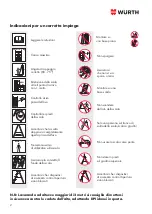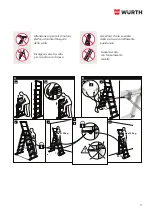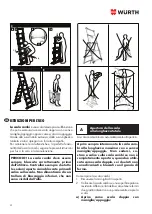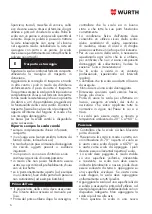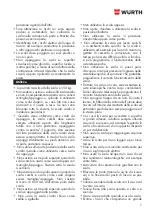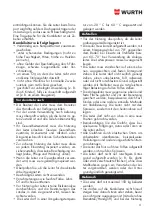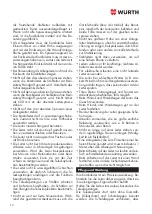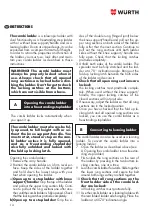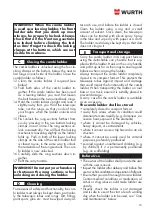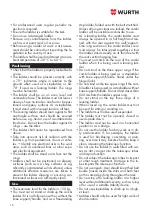
16
• For professional users regular periodic ins-
pection is required.
• Ensure the ladder is suitable for the task.
• Do not use a damaged ladder.
• Remove any contamination from the ladder,
such as wet paint, mud, oil or snow.
• Before using a ladder at work a risk assess-
ment should be carried out respecting the le-
gislation in the country of use.
• The ladder shall be used and stored at an am-
bient temperature of -20° C to 60° C.
• Check that the ladder is properly locked befo-
re use.
• The ladder should be placed correctly, with
a 70° inclination angle in relation to the
ground when used as a stepladder, or 60-
70° if used as a leaning ladder. The rungs
must be horizontal.
• The ladder shall be on an even, level and
unmovable base. The ladder must not lean si-
deways, have no load on one foot or be posi-
tioned on slippery surfaces. As a stepladder,
it must stand with an equal load on all feet.
• The leaning ladder should lean against a flat
non-fragile surface and should be secured
before use, e.g. tied or use of a suitable stabi-
lity device. Do not lean the ladder against its
rungs – use the stiles.
• The ladder shall never be repositioned from
above.
• Take into account risk of collision with the
ladder e.g. from pedestrians, doors or vehic-
les. • Identify any electrical risks in the work
area, such as overhead lines or other expo-
sed electrical equipment.
• The ladder shall be stood on its feet, not the
rungs.
• Ladders shall not be positioned on slippery
surfaces (such as ice, shiny surfaces or sig-
nificantly contaminated solid surfaces) unless
additional effective measures are taken to
prevent the ladder slipping or ensuring con-
taminated surfaces are sufficiently clean.
• The maximum load for the ladder is 150 kg.
• You must not sit, stand or climb up the combi
ladder if it is not fully open with or without the
knee support/handle, and as a freestanding
step ladder, folded out with the belt stretched.
Unless all rung sections are locked, the combi
ladder will be unstable and unsafe to use.
• As a leaning ladder, the combi ladder must
always be opened to its full height and lea-
ned with the rear against the wall/support.
One rung section on the combi ladder’s rear
must always be telescoped together so that
the ladder stands steady on its front feet with
the rear section hanging free.
• You must not climb on the rear of the combi
ladder when it is being used a leaning lad-
der.
• Do not stand on the three upper rungs if the
combi ladder is being used as a stepladder
with knee support/handle. Stand under the
hinged joint.
• Do not stand on the two upper rungs if the com-
bi ladder is being used as a stepladder without
knee support/handle. Do not stand closer than
600 mm from the ladder’s upper rung.
• Do not stand on the top three rungs of a
leaning ladder.
• When closed up, the combi ladder must not
be used for sitting or standing on.
• The ladder must not be used suspended.
• The ladder must not be opened, closed or
used upside down.
• The ladder must not be used in a horizontal
position or as a bridge.
• Do not use the ladder for dirty work or in dir-
ty environments. If, for example, the ladder
is used for bricklaying, concreting or pain-
ting, over time it may become hard to keep it
clean, impairing the telescopic function.
• Do not use the ladder in wells filled with wa-
ter, as dirt can get into the telescopic tubes
and impair function.
• Do not subject the telescopic tubes to impact
or other rough treatment. Damage to the tu-
bes impairs the telescopic function.
• Do not overreach. User should keep their belt
buckle (navel) inside the stiles and both feet
on the same step/rung throughout the task.
• Do not step off a leaning ladder at a higher
level without additional security, such as tying
off or use of a suitable stability device.
• Do not use stepladders to climb up to a high-
er level.
• Ladders should only be used for light work of
short duration.
Positioning
Use
Summary of Contents for 0962 975 23
Page 19: ...19...

